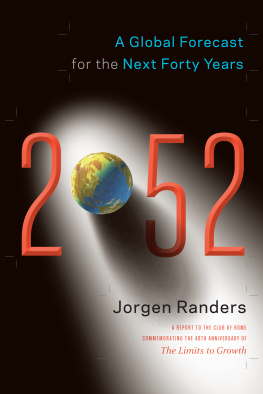Praise for 2052
This thoughtful and thought-provoking book will be inspiring, and challenging, for all who really care about our common future.
Gro Harlem Brundtland,
former prime minister of Norway; leader,
World Commission on Environment and Development
Its too late to wonder how different and refreshingly breathable the world would be if everyone had listened hard to Jorgen Randers forty years ago. The question now is if well heed him this time. Heres our chance. Please seize it, everyone.
Alan Weisman,
author of The World Without Us and Gaviotas
A sober, cogent, and courageous assessment of a future not dictated by fate, or economics, or limits to technology, but by the most egregious leadership failure in history. But there is still time to change course... just enough time and no more.
David W. Orr, Oberlin College,
author of Down to the Wire: Confronting Climate Collapse
This is an extraordinary and profoundly important book. Randers mastery of many fields is impressive, and he presents his best guess future with clarity and force. As a result, he provides a challenging template against which we can judge our own expectations for midcentury.
James Gustave Speth,
author of America the Possible
Read 2052 and get the views of a great futuristone with a fine track record of being right.
Paul R. Ehrlich,
author of The Dominant Animal
An unconventional and lucid explanation of the likely macroeconomic developments of the world over the next forty years.
Lord Nicholas Stern,
author of The Stern Review on the Economics of Climate Change ;
chair, Grantham Research Institute on Climate Change
and the Environment, London School of Economics
With clarity, conscience, and courage, global-systems pioneer Jorgen Randers and his distinguished contributors map the forces that will shape the next four decades. Their sobering but far from despairing insights will encourage all who strive in applied hope to build a society worthy of natures legacy and humans potential.
Amory B. Lovins,
chairman and chief scientist, Rocky Mountain Institute;
senior author, Reinventing Fire ; coauthor, Natural Capitalism

Copyright 2012 by Jorgen Randers.
All rights reserved.
Unless otherwise noted, all illustrations copyright 2012 by Jorgen Randers.
No part of this book may be transmitted or reproduced in any form by any means without permission in writing from the publisher.
Editor: Joni Praded
Project Manager: Patricia Stone
Copy Editor: Cannon Labrie
Proofreader: Nancy Ringer
Indexer: Margaret Holloway
Designer: Melissa Jacobson
Printed in the United States of America
First printing May, 2012
10 9 8 7 6 5 4 3 2 1 12 13 14 15 16
Our Commitment to Green Publishing
Chelsea Green sees publishing as a tool for cultural change and ecological stewardship. We strive to align our book manufacturing practices with our editorial mission and to reduce the impact of our business enterprise in the environment. We print our books and catalogs on chlorine-free recycled paper, using vegetable-based inks whenever possible. This book may cost slightly more because it was printed on paper that contains recycled fiber, and we hope youll agree that its worth it. Chelsea Green is a member of the Green Press Initiative ( www.greenpressinitiative.org ), a nonprofit coalition of publishers, manufacturers, and authors working to protect the worlds endangered forests and conserve natural resources. 2052: A Global Forecast for the Next Forty Years was printed on FSC-certified paper supplied by Thomson-Shore that contains at least 30% postconsumer recycled fiber.
Library of Congress Cataloging-in-Publication Data
Randers, Jorgen.
2052 : a global forecast for the next forty years / Jorgen Randers.
p. cm.
A Report to the Club of Rome Commemorating the 40th Anniversary of The
Limits to Growth.
Includes bibliographical references and index.
ISBN 978-1-60358-467-8 (hardcover) ISBN 978-1-60358-421-0 (pbk.) ISBN 978-1-60358-422-7 (ebook)
1. Economic history21st century. 2. Economic forecasting. I. Title.
HC59.3.R36 2012
330.900112--dc23
2012012065
Chelsea Green Publishing
85 North Main Street, Suite 120
White River Junction, VT 05001
(802) 295-6300
www.chelseagreen.com
For my children and grandchildren
CONTENTS
T his book would not have seen the day of light had it not been for my great fortune in meeting, accidentally, in a physics colloquium at MIT in 1970, the father of system dynamics, Jay W. Forrester, just at the time when he won the contract to do The Limits to Growth study for the Club of Rome. That made me visible for the very able project leader Jay chose to do the project, namely Dennis L. Meadows, who further did the masterstroke of involving Donella H. Meadows, the great, diligent, and warm author of all of our joint publications. All three played central roles in my career, and Dennis and Dana became lifelong friends. I owe them a lot!
I would also like to present my thanks to:
Toyota Norway AS, the BI Norwegian Business School, and the Norwegian Union for Academic Personnel (Akademikerne), for being the unconventional group of sponsors of this forecast;
My old friend Ulrich Golke, for creating the quantitative foundation (statistical data, spreadsheets, and other models) for this forecast;
The forty-one professionals who enthusiastically contributed glimpses of the future to this bookand thereby showed that they are not only independent thinkers, but also able to write;
All my close friends, for having persisted for forty years in systematically opposing my pessimistic views about the future;
My wife, Marie, and daughter, Engelke, for enduring my sadness and encouraging me to continue the fight for a world where humanity will live in sustainable harmony with nature;
WWF, for gathering into one global nongovernmental organization that small minority who really believe the planet is worth saving;
The Club of Rome, who warmly welcomed this book as a report to the Club of Rome, as part of their commemoration of the first report to the Club forty years ago; and
Chelsea Green Publishing, for their long-lasting dedication to the cause and for helping make the presentation readable.
Together we could create a much better world!












